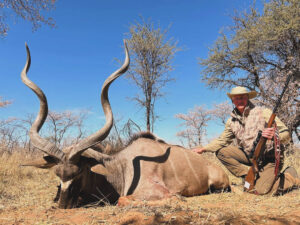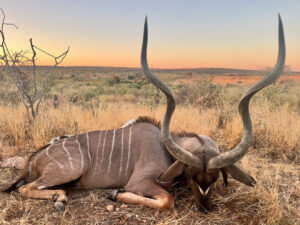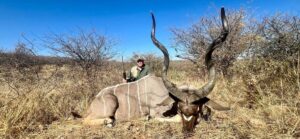Species Spotlight: The Majestic Kudu (kudu safari hunt)
kudu safari hunt
When most hunters dream of an African safari, one species often stands out: the kudu — Africa’s elusive “grey ghost.” With its spiraled horns, regal stance, and elusive nature, the kudu is one of the most sought-after plains game animals on a South African safari hunt.
Whether you’re a seasoned hunter or planning your first African adventure, here’s everything you need to know about hunting this iconic antelope.
🏞️ What is a Kudu?
The greater kudu (Tragelaphus strepsiceros) is one of the largest antelope species in Africa. Found throughout Southern Africa, including South Africa, Namibia, and Zimbabwe, kudus thrive in bushy savannas and lightly wooded areas where their grey-brown coats and white stripes blend perfectly with the terrain.
There are two types:
-
Greater Kudu – Larger, with longer horns and found more commonly in Southern Africa
-
Lesser Kudu – Smaller, with tighter stripes, found mainly in East Africa
On South African safari hunts, we primarily pursue the greater kudu, which can weigh over 600 lbs and grow horns over 50 inches long.


🧭 Why Kudu is a Coveted Trophy ( kudu Trophy Horns)
Kudu are known as the “grey ghost” because of their incredible camouflage and cautious behavior. Their ability to vanish silently into thick brush makes every successful hunt a true achievement.
Trophy hunters prize the kudu for:
-
Its dramatic spiral horns
-
Majestic appearance
-
Challenging pursuit
-
Iconic status in African safari hunting
Safari Hunt Africa , only target mature bulls, ensuring sustainability and proper wildlife management.
🔍 How to Identify a Trophy Bull
A trophy kudu bull typically has:
-
Horns over 45 inches in length
-
A noticeable spiral (2.5–3 full turns)
-
Thick neck, deep chest, and a pronounced beard
-
Mature body with worn horn tips (a sign of age)
Your Professional Hunter (PH) will help assess age and horn length — ensuring a fair chase and responsible harvest.
🎯 Best Hunting Methods
Kudu hunting is a challenge that requires stealth, patience, and good optics. Here are common methods:
-
Spot and stalk: Tracking through brush and terrain to find bulls
-
Ambush near watering holes or game trails
-
Using elevated blinds (especially in dry seasons)
Hunts usually take place early morning or late afternoon, when kudu are most active.
🗓️ Best Time to Hunt Kudu in South Africa
-
April to September (dry season) offers the best visibility and conditions.
-
Cooler weather = more animal movement during daylight
-
Horn growth is mature post-summer
🛠️ Recommended Gear & Caliber
-
Rifle caliber: .30-06, .308, .300 Win Mag, or .338 preferred
-
Optics: Quality binoculars are essential
-
Clothing: Neutral colors, quiet fabrics, and good boots for tracking
Tip: Practice offhand and kneeling shots — kudu rarely give you perfect setups.
🐾 Conservation & Ethical Hunting
Hunting kudu is not only a thrilling experience but also plays a crucial role in wildlife conservation. Regulated, ethical hunting:
-
Funds anti-poaching patrols
-
Supports local communities
-
Encourages habitat preservation
We strictly adhere to South African hunting laws and fair-chase principles.
📸 The Experience Beyond the Hunt
Tracking a kudu through acacia-covered hills or spotting a bull silhouetted against a rising sun is unforgettable. Whether you harvest a bull or not, the pursuit itself is a memory you’ll carry forever.
Many hunters consider their kudu trophy the highlight of their African safari — not just for the animal, but for the journey it represents.
🤝 Book Your Kudu Hunt Today
Ready to take on the “grey ghost” of Africa?
👉 Explore Our Kudu Hunting Packages
📧 Have questions? Reach out at [bookings@safarihunt-africa.com]
📍 Or Book Your Safari Here






